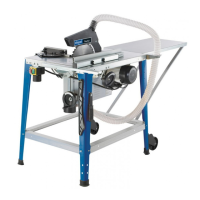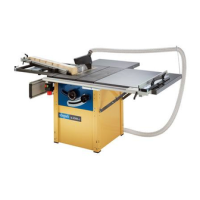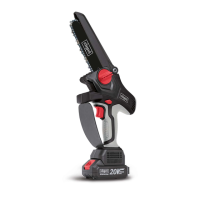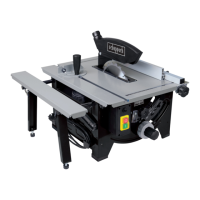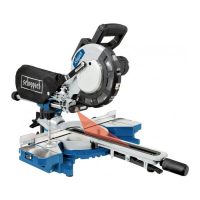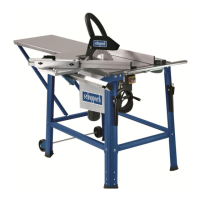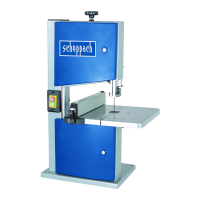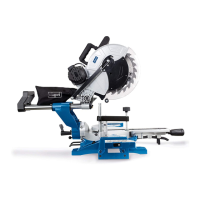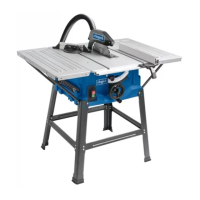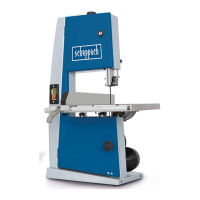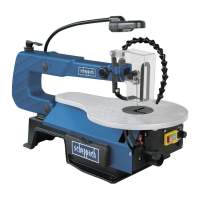• Cutsduetothecablebeingdrivenover.
• Insulationdefectsduetobeingpulledoutofawallsock-
et.
• Cracksduetotheagingoftheinsulation.
Such defective electrical connections should not be used
and are, due to their damaged insulation, mortally danger-
ous!
Electric connecting cable should be checked regularly for
damage. See that when the cables are checked they are
notlive.Electricalconnectionsmustcorrespondtotheap-
propriateVDEandDINnormsandthelocalelectricalregu-
lations.OnlyuseextensionleadswiththelabelH07RN.
Allextension leads must have the typeprintedon them
accordingto law! Extension leads up to 25 metres long
musthaveacrosssectionof1.5squaremillimetres;for
those longer than 25 metres, a cross-section of at least 2.5
squaremillimetresisrequired.
Theconnectiontothepowersourceissecuredwitha16A
carrier.
Connectionsandrepairstotheelectricalequipmentshould
onlybecarriedoutbyanelectricalspecialist.Shouldthere
bequestions,thefollowingInformationisrelevant:
• motormanufacturer,motortype
• typeofcurrentthemotoruses
• dataonthemachineandtypesigns
• datafortheelectricaldrive.
Should the motor be returned, it should be sent as a com-
pleteunit.
ThroughpoorconditionsoftheelectricalMAINS,shortly
voltagedrops
• canappearwhenstartingtheEQUIPMENT.Thiscanin-
uenceotherequipment(e.g.blinkingofalamp).
• IftheMAINSIMPEDANCEZmax<0.27OHM,suchdis-
turbancesarenotexpected.
(Incaseofneed,youmaycontactyourlocalsupplyauthor-
ityforfurtherinformation).
Means of Correction
Adjustmentoftheslantingboard(g.8,9,10,11)
Note: In order to maintain an exact saw cut, before begin-
ning the operation the position should be checked and, if
necessary, adjusted.
90°-Position (fig. 8, 9, 12)
• Releasetheclampinglever(4,g.12)andpositionthe
sawunitat90°,whilethechocklever(4,g.9)isinthe
presseddownposition.
• Puttheanglegaugeonthebevellingtablewithoneside
against the table and the other against the saw blade.
• Shouldtheanglegaugenotlieexactlyatalongthesaw
blade,releasethefourpositioningscrews(1,g.8)on
the back of the body with a 5 mm Allen key. Pull the
chockroughly17.5mmbackwardssothatitjustpasses
throughthecastpart(2)ofthebackofthebody.
• Tiltthearmtotheleftuntilitclicks,withouttouching
the chock. Put the gauge on the table and bring the head
slowlyto90°.Donotgopastthispoint.Shouldthishap-
pen,tiltthesawheaddownagainandbringitto90°.
• Positiontheclampingleverandtightenthefoursixsid-
ed bolts after the adjustments have been made.
Indicator Position for the Saw Blade Slant (fig. 9)
Oncethepositionfor90°hasbeenachieved,adjustthein-
dicator(2)sothatitpointsto0°ontheslidingscale(3).To
dothisreleasetheindicatorscrew(1)withascrewdriver,
adjust the dial and then tighten the screw again.
Chock adjustment for 45° to the left (fig. 9, 10, 12)
• Pushtheslidingchock(19,g.1)completelytotheleft,
andthenpulltheslantlockingmechanism(1,g.10)
forward.
Pleasenote:whenyouwishtopullthechockbackitmay
benecessarytoshifttheuppersawingarmtotheleftor
therightinordertoreleasetheholdingpressure.
• Releasetheclampinglever(4,g.12)andtiltthesaw
armcompletelytotheleft.
• Useananglegaugeandcheckwhetherthesawbladeis
ata45°angletothetable.
• Forpositioning,tiltthesawarmto0°,releasethesafety
nut(5,g.10),andturnthescrew(6,g10)oneway
ortheotherinordertoIncreaseorreducetheangle(g.
9).
• Tilt the saw arm backtotheleft and check the posi-
tion.
• Repeatthesestepsuntilthebladeisata45°angleto
the table. Once this is achieved, tighten the safety bolt
(5,g.10)inordertosecurethechockscrew.
Chock adjustment for 45° to the Right (fig. 9, 10, 12)
Repeatthestepsdescribedabovefortherightside.
33.9° Slanted Position (fig. 11)
• Placethebevelangleat0°.Positionbothoftheplate
chocks outward.
• Releasetheclampinglever(4,g.12)andtiltthesaw
armtothechock33.9°bypushingthechockpegback-
wards.
•Usetheanglegaugetocheckwhetherthebladeisposi-
tioned at an angle of 33.9° to the table.
• Toinstall,turnthescrewthreadwithanAllenkey(see
arrow,g.11)untilthebladeissetatanangleof33.9°
to the table.
• Repeatthesestepsfortheslantangleof33.9°onthe
right side.
Bevel Angle Position / Spring Chock Position (fig. 12)
Thebevelscaleshowsabevelanglefrom0°to45°tothe
left and from 0° to 60° on the right. The most usual angle
slits have spring positions in order to make it easier to
achieveaquickandprecisepositioning:
• Raisethespringgripandtherebyunlockthetable.
• Movetherotatingtablewhileraisingthespringgrip(1)
inordertosettheindicator(2)atthedesiredangle.
• Lockthetableintothedesiredpositionbyreleasingthe
springgrip.
Bevel Scale Indicator (fig. 12)
• Putthetableintothe0°position.
• Useascrewdrivertoreleasethescrew(3)whichholds
the indicator.
• Adjusttheindicator(2)tothemarkingfor0°andtighten
the screw.
Positioning the Blade to the Chock (fig. 13)
• Turntheupperarmtothe0°positionandratchetitin.
• Loosenthefourchocklockingscrews(1)withaturnof
theAllenkeyuntilthechock(2)isloose.
• Movethesawheaddownandlockittherewiththechock
peg.
• Placethebackoftheanglegauge(3)againsttheblade,
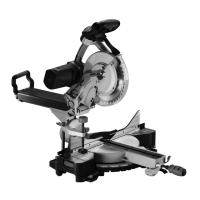
